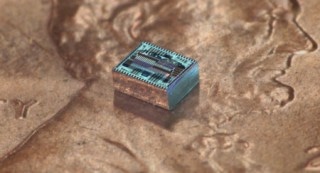Jun 23 2017
Traditional cameras—including those found on the thinnest of cellphones—cannot be really flat because of their optics: lenses that need a specific size and shape in order to function. Recently, Caltech Engineers have created a new camera design that swaps the lenses with an ultra-thin optical phased array (OPA).
The OPA are able to computationally do what lenses do using large pieces of glass: it regulates incoming light to capture an image.
 The OPA chip placed on a penny for scale. (Credit: Caltech/Hajimiri Lab)
The OPA chip placed on a penny for scale. (Credit: Caltech/Hajimiri Lab)
The curve in lenses bends the path of incoming light and directs it onto a film strip, in the case of digital cameras, an image sensor. The OPA has a large selection of light receivers, each of which can individually integrate a firmly controlled time delay (or phase shift) to the light it receives, enabling the camera to selectively look in various directions and focus on a variety of things.
"Here, like most other things in life, timing is everything. With our new system, you can selectively look in a desired direction and at a very small part of the picture in front of you at any given time, by controlling the timing with femto-second—quadrillionth of a second—precision," says Ali Hajimiri, Bren Professor of Electrical Engineering and Medical Engineering in the Division of Engineering and Applied Science at Caltech, and the main investigator of a paper illustrating the new camera. The paper was presented at the Optical Society of America's (OSA) Conference on Lasers and Electro-Optics (CLEO) and published online by the OSA in the OSA Technical Digest in March 2017.
Ultra-Thin Camera Creates Images Without Lenses
We've created a single thin layer of integrated silicon photonics that emulates the lens and sensor of a digital camera, reducing the thickness and cost of digital cameras. It can mimic a regular lens, but can switch from a fish-eye to a telephoto lens instantaneously—with just a simple adjustment in the way the array receives light.
Ali Hajimiri, Bren Professor of Electrical Engineering and Medical Engineering in the Division of Engineering and Applied Science, Caltech
Phased arrays, which are used in radar and wireless communication, are groups of individual transmitters, all transmitting the same signal as waves. These waves interfere with each other both constructively and destructively, intensifying the signal in one direction while canceling it out somewhere else. Therefore, an array can produce a closely focused beam of signal, which can be steered in various directions by staggering the timing of transmissions made at numerous points across the array.
A related principle is used in reverse in an optical phased array receiver, which is the center for the new camera. Light waves that are received by each element throughout the array cancel each other from all directions, excluding one. In that direction, the waves strengthen each other to produce a focused "gaze" that can be electronically regulated.
What the camera does is similar to looking through a thin straw and scanning it across the field of view. We can form an image at an incredibly fast speed by manipulating the light instead of moving a mechanical object.
Reza Fatemi, Graduate Student and Lead Author of the OSA paper
In the past year, Hajimiri's team introduced a one-dimensional version of the camera that was capable of detecting images in a line, such that it behaved like a lensless barcode reader but without any mechanically moving parts. This year's progress was to construct the first two-dimensional (2D) array with the ability to create a full image. This first 2D lensless camera has an array made up of just 64 light receivers in an 8 by 8 grid. The image achieved has low resolution. But this system signifies a proof of concept for a major rethinking of camera technology, Hajimiri and his colleagues say.
"The applications are endless," says Graduate Student Behrooz Abiri (MS '12), Co-Author of the OSA paper. "Even in today's smartphones, the camera is the component that limits how thin your phone can get. Once scaled up, this technology can make lenses and thick cameras obsolete. It may even have implications for astronomy by enabling ultra-light, ultra-thin enormous flat telescopes on the ground or in space."
"The ability to control all the optical properties of a camera electronically using a paper-thin layer of low-cost silicon photonics without any mechanical movement, lenses, or mirrors, opens a new world of imagers that could look like wallpaper, blinds, or even wearable fabric," says Hajimiri. Going forward, the team will be involved in scaling up the camera by building chips that enable much larger receivers with higher sensitivity and resolution.
The research paper is titled "An 8X8 Heterodyne Lens-less OPA Camera." The research was funded by the Caltech Innovation Initiative (CI2).